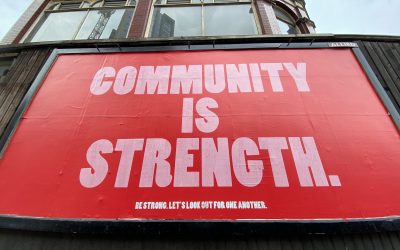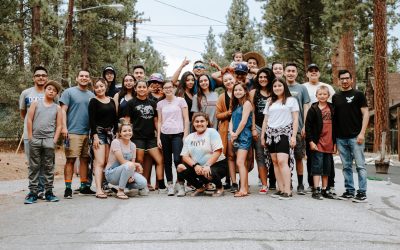*With many of you folks who read my blog having an active interest in participating or growing a community of some sort, I am re-printing some portions of my book, [The Art of Community](https://www.artofcommunityonline.org) on my blog. I would feel guilty about doing this if it weren’t for the fact that the book is entirely free and [available for download](https://www.artofcommunityonline.org/get/), although if you can afford to, do [buy a copy so you can to support O’Reilly in publishing Creative Commons books](https://www.artofcommunityonline.org/get/)*.
> “Before I speak, I have something important to say.” — Groucho Marx
When I was 11 years old, my friend somehow obtained an LP he had “borrowed without asking” from his brother. He handed me the large disc adorned with cardboard sleeve, all
carefully buried in a white plastic bag. As I retrieved said sleeve from said bag, my eyes widened and I skipped a breath: it was the first time I witnessed the sheer brilliance of an Iron Maiden record.
I listened to that LP until it damaged the pin in my record player. I loved the energy, I loved the look (including the spandex…I am not kidding), and I just wanted to be them. Unfortunately I had neither talent nor spandex but merely a bowl haircut and large white socks.
Inspired, I decided I was going to learn to play the guitar. My parents bought me an old acoustic guitar and I parked myself on my bed night after night trying to sound like my rock and roll heroes. Of course, I instead sounded like an incompetent 11-year-old with an acoustic guitar. I sucked, but I stuck at it.
As the years rumbled on, so did my guitar playing. Fortunately my skills were improving and I was reading more and more about music, guitarists, and the bands I loved. While flicking through a copy of Guitarist magazine, I came across a quote that I seem to remember was from Eric Clapton, but I’m not quite sure. Whoever it was, his words really resonated with me (pun intended):
> It’s not the notes you play, it’s the notes you don’t play.
While I am still making oodles of music today, this quote didn’t really take hold of me until five years later when I started writing. What the little nugget of wisdom infers is that although we may obsess over the obvious components in an art (such as the notes in music), it is often the hidden and underlying messages that offer the most value (such as not playing certain notes).
This is a strong and relevant message for building communities. Community is absolutely about understanding the ether. Our notes are the processes, governance, tools, and methods in which we work together. The notes we don’t play are the subtle nuances in how we pull these notes together and share them with each other. The space between the notes is communication.
## He Said, She Said
Communication is essential in community. It is the metaphorical highway that connects the many towns and people in your world. Effective communication brings together your
community members in a manner that is free-flowing, productive, and accessible. You may spend hours putting together elegant and sleek processes, infrastructure, and governance, but if your community can’t communicate well with each other, you may as well pack up your bags and go and pursue a career in cabaret on The Love Boat.
Our analogy with highways and towns maps eerily well to how we wire up our community with the communication channels it needs. To ensure our towns can work together, we have
two primary tasks on our hands:
* **Create the highways** – first, your community needs to build a set of resources to facilitate communication, discussion, and the sharing of ideas and best practices. In many cases these resources are online facilities, such as mailing lists, forums, and discussion channels.
* **Encourage great driving** – once your communication channels are in place, they can be used in all manner of ways. There will of course be some good drivers and some bad drivers; some will communicate exceptionally well, and some will irritate and agitate anyone who crosses their path. You want to inspire and encourage a baseline quality of communication. This is not about excluding people who are imperfect writers or speakers, but instead about providing a consistent example of simple approaches to communication that make the community easier to understand and more pleasurable for everyone involved.
In this chapter we are going to cast our sights on both of these topics, discuss a range of mediums for building the free flow of communication, make good use of those facilities, incorporate transparency, and avoid the common problem of a community preferring to speak rather than do.
So, let’s get started by laying down the highways and putting some cars on the road. Now is the time to build our community’s communication backbone….
## Building Your Communication Channels
Good communication serves many purposes in a community. It is the foundation of how your members work together, share goals and ambitions, and build social relationships between each other. It is communication that ensures everyone is on the same page, heading in the same direction, marching to the same tune.
Good communication is also a powerful security blanket. When communication breaks down in community, it can cause havoc. Volunteer communities are driven by members with a set
of values that reflect themselves and the values of the wider community. These values are important to regularly reinforce in your community: they are the metabolism that fights off the threats and problems that can undermine the goals of the community. When your members feel like they are disconnected from the community, they lose their sense of value.
Communication can be divided into three primary areas:
* **Incoming** – receiving and processing feedback and viewpoints for the purpose of improvement. An example of this could include surveys to determine how well a part of your community is working.
* **Outgoing** – sharing news, stories, and achievements from the community with the rest of the world. An example of this could be showing off something your community has created.
* **Internal** – internal discussions and meetings in the community to discuss objectives, goals, conflict, and other issues. An example of this could include meetings that are designed to decide on how your community will work together toward its goals.
Each of these forms of communication is essential for a strong community. All communities need open and objective feedback. They should all share their achievements and what they have produced. Finally, all communities need to have regular internal discussion and meetings to ensure everyone is interacting smoothly. Great communication should be a goal for the many different parts of your community, as opposed to one specific area. When we get great communication right, community feels vibrant, thriving, and accessible.
We are going to cover all three of these topics in this book. Incoming communication will be discussed in Chapter 7, outgoing will be discussed in Chapter 6, and we discuss internal communication here.
## Striving for Clarity
As communication is critical to the success of your community, it is stunning how many communities just get it plain wrong. Many are plagued with long-winded, overly complex, and difficult-to-use communication channels, and it seems you need a degree in rocket science to understand how to join these channels. Then, it seems you need to go back to school to get a degree in computational linguistics to then fit into the culture and expectations of these communications channels. Many have an unwritten rule book stapled to the side of the channel, and if you are unfamiliar with its scriptures, the response can be terse, forthright, and sometimes outright rude. This is the last thing you want. Instead, you want to create simple, efficient, welcoming, and enjoyable methods of keeping in touch with other members of the project.
The greatest form of communication is always going to be sitting in a room with a real person, face to face. In this setting you can speak freely, your words flowing as quickly as your brain conjures them up, with body language, gestures, and facial expressions further augmenting the flow of conversation. Any technological form of communication is going to compromise some of these attributes. Of course, many who are socially uncomfortable in face-to-face situations will hail the muting of these additional attributes in conversation as a victory for accessibility and openness.
When laying down the lines of communication for your community, our goal is to strive for clarity. Imagine if you will a world in which every communication is clear, accessible, and well understood by your community. You need to think carefully about the culture in which your community communicates and strive to build a highway and driving style that achieves that culture. You first need to lay the foundations, which can be found in clarity and transparency.
Your members want to be able to hear, read, or experience each communication and understand it straightaway. When clarity is in place, contributions will begin to flow shortly
afterward. When confusion, misunderstanding, and opacity set in, your members will either spend their days seeking clarification or move on, confused and frustrated.
Clarity and transparency are also important in attracting new members. For example, most online communities’ communication channels are indexed by search engines. How many times have you typed something into Google and some of the results that appear are mailing lists, forums, or other online discussions that are happening inside a community? Potential new community members will read these discussions and it will affect their desire and willingness to join your community. If the communications are complex, socially fraught, or otherwise suboptimal, potential members may prefer to spend their valuable spare time playing Guitar Hero rather than joining you and your band of merry men and women.
Achieving clarity requires attention to two areas. First, a sensible choice of communication medium is required (mailing list, IRC, forum, etc.). This is relatively straightforward and actually fairly uninteresting. We will make some decisions about this over the following pages.
The second, more complex part is picking communication channels that match the needs of the users while maximizing clarity. Let’s spend some time talking about that.
## Choices, Choices
Your community has oodles of communication channels to choose from, each with qualities that make sense in different scenarios and to different people. The goal is to match the right medium to your community and to understand the pros and cons of that medium to help the pros bubble to the surface and keep the cons well away from the kitchen.
Picking an appropriate medium is largely about understanding your contributors and their workflow. Each type of contributor will have different preferences. Software developers
generally prefer content to be delivered directly to them. They are generally most comfortable with mailing lists and RSS feeds (updated content from websites and online resources) and don’t like to have to refresh a browser to see if new content exists. This is part of why many (typically western) developers don’t get on very well with forums. Some communities have bridged this divide by proving gateways so a mailing list post goes to a forum and vice versa (an example of this is the [Banshee project](https://banshee-project.org/support/).
> Note: Of course, many developers do love forums. The last statement was based upon general experience with developers over a range of projects and development cultures, largely in western countries. If you know developers who love forums, don’t be alarmed: we are all friends here.
Users are (typically) different. Users often love forums for their accessibility and simplicity. The conversation flow is clear, the interface is friendly, and the web browser is a familiar window to that world. Users are used to having to refresh their browser to see if updates exist. They are used to visiting many websites to find content, and they generally feel uncomfortable about technical barriers to these discussions and content. Users just don’t like to jump through hoops, particularly technical hoops that can easily trip them up. Believe it or not, these roles are fairly set in stone. Trying to persuade a developer to use a forum can be like persuading a cat to chase after a stick. A developer may agree to give it a shot, but I can almost guarantee you that it won’t work out. Communication channels are highways of habit: people have their preferences and they generally stick to them.
At the beginning of a community you need to know which roles and personalities are most comfortable with which communication mediums; this is the very first step in building great communication. You can then make informed choices. We will explore some of these common mediums and some notes that can help inform these choices in just a moment.
Communication fetishism Another key consideration when building effective communication channels is keeping discussion focused. This is a two-part process in avoiding communication fetishism and also keeping all your eyeballs in one place.
Communication fetishism is particularly prevalent in online and technical communities and points to the problem of new communities wanting to provide every possible communication channel under the sun. They set up mailing lists, forums, IRC channels, Second Life worlds, and more. This is the wrong thing to do. You should instead identify the key roles and personalities in your project and choose mediums that make the most sense to those roles.
Let’s look at an example.
When I set up the Jokosher project, I knew that the primary roles in the community were going to be users and developers. I wanted to ensure that the project had communication
channels for technical discussion about the development of the application, but also a place for musicians to discuss Jokosher, share tips, and show off their compositions. I decided to set up a mailing list for developers and a forum for the users. These mediums reflected the respective developer and user roles well. The only other medium I set up was a `#jokosher` IRC channel for real-time discussion and meetings for the developers. Although the channel exists, we never point regular users to that channel; the forum is far more appropriate.
The second part of the process is “keeping all your eyeballs in one place.” One of the mistakes a lot of new communities make is to fragment individual communication mediums too heavily. Let’s look at another example.
When we started LugRadio, I wanted us to provide a place for listeners to talk about the show and the topics in each episode. Forums were the best choice, so I set them up.
In most discussion forums you can have a number of subforums. As an example, if you had a software project, you could have subforums for General Discussion, Development,
Documentation, etc. When I set up the LugRadio forums I created three subforums: General Discussion, Ideas for the Show, and Mirrors. Each subforum had a clear purpose for discussion. In contrast to many other forums, we had a tiny number of subforums. Many new forums have 10 or more subforums, and we had 3. This was deliberate. When you set up a new community, you want to generate discussion quickly. You want to initiate the discussion but encourage and inspire others to participate and get involved. If you have a forum with too many subforums, you will fragment the discussion: you will get many tiny bits of discussion across the subforums, and little consistency. Keep the discussion in just a few places, and conversation will flow.
This happens because people waste time choosing the right forum instead of just posting. What is worse, some get confused and just don’t post at all. Discussion gets going faster when you have fewer choices.








